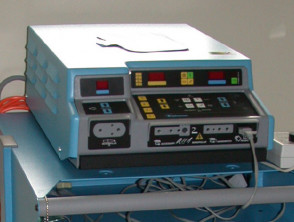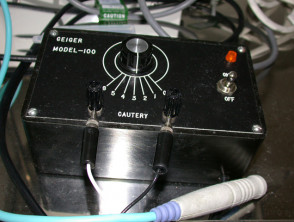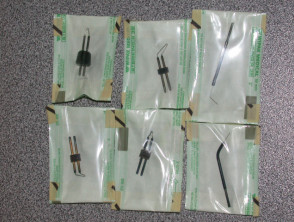Introduction
Electrosurgery is used in dermatological procedures to stop bleeding (haemostasis) or to destroy abnormal skin growths.
In electrosurgery, high-frequency, alternating electric current at various voltages (200 to 10,000 V) is passed through the skin to generate heat. It requires a power supply and a handpiece with one or more electrodes. The device is controlled using a switch on the handpiece or a foot switch.
Electrosurgery devices
Terminology used in electrosurgery
Some of the terminology used to describe electrosurgery is confusing. The aim of the procedure is to perform cauterisation. The word cautery originates from the latin, meaning to brand. It relates to the coagulation or destruction of tissue by heat or a caustic substance.
Electrosurgery (particularly electrocoagulation) is sometimes incorrectly called diathermy, which means ‘dielectrical heat’. Diathermy is produced by rotation of molecular dipoles in high frequency alternating electric field – the effect produced by a microwave oven.
The term electrocautery is most often used in reference to a device in which a direct current is used to heat the cautery probe. As no current flows through the patient, this is not a true form of electrosurgery. It is therefore preferable to use the term thermocautery for these devices.
Electrosurgery includes:
- Electrofulguration (results in sparks)
- Electrodesiccation (dehydration of superficial tissue)
- Electrocoagulation (cause bleeding blood vessels to clot)
- Electrosection (cut through tissue)
- Thermocautery
- Radiofrequency devices (very high frequency, for cutting [>1,500kHz])
Electrosurgery may be monoterminal, monopolar or bipolar.
Monoterminal electrosurgery
- Handpiece has single electrode.
- Indifferent electrode is not required.
Monopolar electrosurgery
- Uses single pointed probe to carry electrical current from power generator to surgical site.
- Requires indifferent electrode, typically large metal plate or flexible metalised plastic pad placed on skin distant from surgical site.
- Current passes from tip of probe through patient to indifferent electrode and completes circuit by returning to electrosurgical generator.
Bipolar electrosurgery
- Uses forceps with both tines connected to power generator: one is active and other is indifferent electrode.
- Current runs through tissue grasped by forceps.
- Used in patients with implanted cardiac devices such as a pacemaker or defibrillator, to prevent electrical current passing through the device, which might short-circuit or fire inappropriately.
Waveforms in electrosurgery
Different waveforms may be generated by the electrosurgery machine for different procedures.
- Continuous single, high frequency (>400 V) sine wave used at high heat for cutting / vaporisation leaves a zone of thermal damage. A high pitched sound is heard.
- Pulsed or modulated waveforms allow tissue to cool between bursts so that the zone of thermal damage is minimal.
- A sine wave turned on and off in a rapid succession (rectified) produces the slower heating process that results in coagulation. A rougher, lower tone is heard due to lower power.
- Variable waveforms can be produced to blend cut and coagulation, as power is adjusted in real time depending on tissue impedance.
Electrofulguration and electrodessiccation
Electrofulguration and electrodesiccation are used to destroy superficial lesions that are unlikely to bleed profusely when disturbed, such as viral warts and seborrhoeic keratoses.
Electrofulguration and electrodesiccation use a single electrode to produce high voltage and low amperage current. The current accumulates in the patient but there is minimal tissue damage.
Electrofulguration
- Electrofulguration is used to treat skin tags and protruding warty lesions such as seborrhoeic keratoses, viral warts, xanthelasma and dermatosis papulosa nigra.
- Electrode is held 1–2 mm from skin surface, and produces spark or electric arc.
- This causes superficial tissue dehydration and carbonisation over wide area.
- High voltage allows current to overcome resistance of air gap between tissue and electrode tip.
- Carbonised epidermis insulates and minimises further damage to the underlying dermis.
Electrodesiccation
- Electrodesiccation is used to remove flat seborrhoeic keratoses and lesions under the skin such as syringoma, milia, comedones, sebaceous hyperplasia and molluscum contagiosum.
- It can be also used for hair removal and to treat fine facial blood vessels.
- Electrode contacts skin directly and heats it up
- Results in dehydration of surface and slightly deeper skin
- Dry coagulum forms on skin surface.
- Treated areas usually heal rapidly with minimal scarring or loss of pigment
Caution
Unless bipolar output is used, the patient must be on an insulated table, as burns may result from current passing between patient and the earth-ground. Electrofulguration and electrodesiccation should only be performed on conscious patients who would feel the burn from an unwanted earth-ground path.
Hyfrecator
The Conmed Hyfrecator® is a brand name for a low-powered electrosurgical device used for electrofulguration, electrodessication and electrocoagulation. The term ‘hyfrecation’ is often used generically to describe similar devices made by other manufacturers. The power output is adjustable, and the pencil handpiece may be equipped with different stainless steel tips, including the following types.
- Sharp straight and angle tipped needle electrodes of varying length and diameter are used for pin-point haemostasis and hair removal.
- Blade shaped blunt tipped electrode is used for incisions.
- Blunt tips and ball tips are used for electodessication and electrocoagulation.
- Adapters can be used with hypodermic needles to treat very fine telangiectasias
- Bipolar forceps are used for precise coagulation or to grip pedunculated lesions and may have micro tips, smooth or serrated tips.
- Disposable tips reduce chance of transmitting microbial infection and can be replaced when eschar builds up.
- Tips coated with Teflon® (polytetrafluoroethylene or PTFE) or elastomeric silicone reduce eschar build-up and can be wiped clean with a sponge.
- Sheaths are available to protect the handpiece from contamination.
Electrocoagulation
Electrocoagulation is used to cause deeper tissue destruction and to stop bleeding with minimal carbonisation. The haemostatic and destructive capacity of electrocoagulation makes it ideal for the treatment of skin cancers and vascular skin conditions such as pyogenic granuloma. It can also be used to stop small blood vessels from bleeding during skin surgery.
Electrocoagulation uses monopolar or bipolar electrodes to produce low voltage and high-amperage current at relatively low power. An indifferent electrode prevents accumulation of current in the patient, hence low voltage is sufficient to establish current flow. High amperage causes deep tissue destruction and haemostasis by fusion of blood vessel collagen and elastic fibres.
The electrode is applied across the lesion until slightly pink to pale coagulation occurs. Coagulated tissue has greater resistance to electrical current than normal skin, and limits the amount of damage.
Electrocoagulation may result in permanent scarring and white marks (hypopigmentation).
Electrosection
Electrosection is used to simultaneously cut skin and seal bleeding vessels by blending damped and undamped wavetrains. It is suited for excision of large, relatively vascular lesions, such as benign dermal naevi (moles), skin tags, or for shaving off seborrhoeic keratoses, folliculitis keloidalis nuchae and rhinophyma (see rosacea). Electrosection requires almost no manual pressure from the operator as the electrode glides through tissue with minimal resistance.
Electrosection uses an monopolar electrode to produce low-voltage and high-amperage current at higher power than is used for electrocoagulation. The current is highly focused to vaporise tissue with minimal peripheral heat damage. The electrode is usually a fine tungsten wire or loop.
The destruction of chemical bonds or decomposition of tissue arises through thermolysis (heat-induced) and electrolysis (via DC electric-current). The main component of tissue is water, which is broken down into its components, hydrogen and oxygen.
Radiofrequency devices are often used for electrosection, e.g. Ellman Surgitron®. They produce little heat so cause little collateral tissue damage.
An assortment of single use or disposable electrodes are available for the Surgitron.
- Needles are available in various lengths and diameters.
- Shaft may be straight, at an angle or curved.
- Cutting wire, round, triangle or diamond-shaped loops come in various diameters and wire size.
- Ball tips of various size can be used for coagulation.
- Blade ‘scalpel’ electrodes
- Insulated, coated needles can be used for sclerotherapy or internal sites.
- Special handpieces can be used for nonablative skin tightening (radiothermoplasty).
- Compared with surgical removal, benefits of electrosection include reduced surgical time, reduced post-operative complications (pain, swelling, infection), maximum readability of histologic specimen, enhanced healing and excellent cosmetic results. No sutures are necessary when it is used to remove small skin lesions flush with the normal skin contour.
Thermocautery
Thermocautery is used for pinpoint haemostasis during surgical procedures or to get rid of small blood vessels (telangiectasias).
Direct electric current is used to heat the surgical element, which then causes thermal injury by direct heat transference to the tissue. In contrast, in electrosurgery, the treating electrode remains cold.
Portable and disposable thermocautery devices are available powered by penlight batteries. The Shaw Hemostatix® Scalpel is a form of thermocautery in which a heated disposable copper alloy blade is used to cut tissue with reduced bleeding in highly vascular areas.
Thermocautery is suitable for patients with an implanted pacemaker or defibrillator.
Risks of electrosurgery
The risks of electrosurgery include electric shock and electrical burns, thermal burns, transmission of infection and production of toxic gases.
Electric shock
Electric shock can be minimised by:
- Use of earthing/indifferent electrode
- Surgeon wearing plastic surgical gloves
Electric/thermal burns
Electric/thermal burns can be minimised by:
- Use of non-flammable cleanser such as chlorhexidine or povidone-iodine
- Ensuring indifferent electrode has broad contact with skin and is not placed over a bony prominence, scar tissue, or implanted metal
- Ensuring patient is not in contact with grounded metal objects
- Removal of eschar: this is a fire hazard as it can ignite.
Transmission of infection and production of toxic gases
Electrosurgery may be used to treat viral warts. Thermolysis will generate smoke/fumes which may contain human papillomavirus (HPV) particles that may be transmitted to the operator who breaths in or comes into contact with the fume. When working with HPV-related lesions, minimise the risk of transmission.
- Use smoke evacuator with intake nozzle 2 cm from operative site
- Wear surgical mask (N95 is most effective) and eye protection.
Other viral DNA, bacteria, carcinogens, and irritants are also known to be present in electrosurgical smoke. NIOSH (the National Institute of Occupational Safety and Health) a division of CDC (Center for Disease Control, USA) have also studied electrosurgical smoke at length. They state: “Research studies have confirmed that this smoke plume can contain toxic gases and vapors such as benzene, hydrogen cyanide, and formaldehyde, bioaerosols, dead and live cellular material (including blood fragments), and viruses.”
Smoke can be removed using hand held suction. Newer smoke evacuation devices can be attached directly to a standard electrosurgical pencil reducing the work of an assistant during surgery.
Cardiac pacemaker and defibrillators
Electric currents from electrosurgery electrodes pass through the patient's body to the indifferent electrode. This may sometimes cause malfunction of implanted cardiac devices.
This risk may be mitigated in the following ways.
- Use thermocautery including Shaw scalpel (no current flow through patient)
- Use bipolar forceps with electrosurgery device (minimises current through patient)
- If possible, avoid operating near the implanted device
- Change pacemaker to fixed-rate mode or magnetically deactivate implantable cardioverter-defibrillator during electrosurgery.
Pre and postoperative input from a cardiologist may be required in complex patients.


